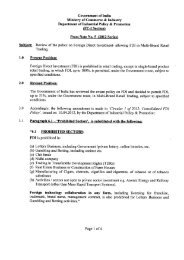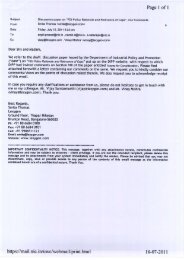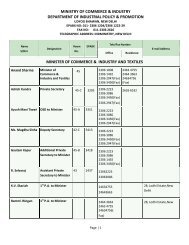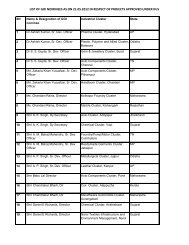fdi in india and its growth linkages - Department Of Industrial Policy ...
fdi in india and its growth linkages - Department Of Industrial Policy ...
fdi in india and its growth linkages - Department Of Industrial Policy ...
You also want an ePaper? Increase the reach of your titles
YUMPU automatically turns print PDFs into web optimized ePapers that Google loves.
FDI IN INDIA AND ITS GROWTH LINKAGES<br />
The backward l<strong>in</strong>kage <strong>in</strong>dex, BL j is computed as:<br />
The backward l<strong>in</strong>kage for sector j reflects the effects of one unit <strong>in</strong>crease <strong>in</strong> f<strong>in</strong>al dem<strong>and</strong> <strong>in</strong> this sector on overall<br />
economic activity.<br />
The forward l<strong>in</strong>kage effect, FL i , is computed as:<br />
The forward l<strong>in</strong>kage for sector i reflects the effects of one unit <strong>in</strong>crease <strong>in</strong> production of sector i on overall economic<br />
activity.<br />
5.3 Sectoral L<strong>in</strong>kages with FDI Inflows<br />
L<strong>in</strong>kage effects have been computed for all 130 IOTM sectors. Sectors have then been identified under four different<br />
categories, viz.:<br />
a) KY: key sectors with strong backward <strong>and</strong> forward l<strong>in</strong>kages (BLj > 1 <strong>and</strong> FLi > 1);<br />
b) BW: strong backward l<strong>in</strong>kages (BL j > 1 <strong>and</strong> FL i < 1);<br />
c) FW: strong forward l<strong>in</strong>kages (BL j < 1 <strong>and</strong> FL i > 1); <strong>and</strong><br />
d) NK: non-key sectors with weak backward <strong>and</strong> forward l<strong>in</strong>kages (BL j < 1 <strong>and</strong> FL i < 1).<br />
Sectors disaggregated under these four categories are presented <strong>in</strong> Tables 5.1 to 5.4.<br />
IOTM sectors which have strong backward <strong>and</strong> forward l<strong>in</strong>kages (KY) <strong>in</strong> India’s economic structure <strong>in</strong>clude electricity<br />
(IOTM sector number 107), petroleum products (63), l<strong>and</strong> transport (110), non-ferrous basic metals (80) <strong>and</strong> iron, steel<br />
<strong>and</strong> ferrous alloys (77) (Table 5.1). Some of the KY sectors have relatively high backward l<strong>in</strong>kages, while others have<br />
relatively high forward l<strong>in</strong>kages.<br />
Sectors with high backward l<strong>in</strong>kages (BW) <strong>in</strong>clude electronics equipment (94); electrical wires <strong>and</strong> cables (89); batteries<br />
(90); electrical <strong>in</strong>dustrial mach<strong>in</strong>ery (88); <strong>and</strong> art silk & synthetic fibre textiles (50) (Table 5.2).<br />
Sectors with high forward l<strong>in</strong>kages (FW) <strong>in</strong>clude trade (116); bank<strong>in</strong>g (118); crude petroleum (29); coal <strong>and</strong> lignite (27);<br />
<strong>and</strong> communications (115) (Table 5.3).<br />
F<strong>in</strong>ally, sectors with weak BW <strong>and</strong> FW l<strong>in</strong>kages (NK) <strong>in</strong>clude agricultural products; some of the m<strong>in</strong>eral products;<br />
tobacco products; wood <strong>and</strong> wood products; <strong>and</strong> some of the services (Table 5.4).<br />
The 4-digit DIPP-classified sectors have then been arranged <strong>in</strong> descend<strong>in</strong>g order of FDI <strong>in</strong>flows. These sectors have<br />
been classified under four l<strong>in</strong>kage categories based on their match with IOTM sectors. The top 15 aggregate DIPP 4digit<br />
sectors account for about 95 per cent of the total FDI <strong>in</strong>flows dur<strong>in</strong>g 2000-2007 (Table 5.5).<br />
Four sectors among the top 15 DIPP sectors <strong>in</strong>clude key sectors (KS), viz., miscellaneous <strong>in</strong>dustries <strong>in</strong>clud<strong>in</strong>g<br />
50












